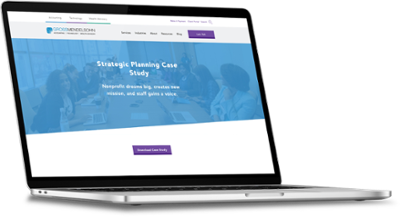When it comes to strategic planning, there are several key steps that organizations must prepare themselves for. Strategic planning is the formal process of determining an organization’s long term goals and identifying the best approach to take to achieve those goals. This usually involves key people in an organization, sometimes with the help of outside advisors, who analyze the organization’s strengths, weaknesses, opportunities and threats.
This short video offers tips for developing your nonprofit's strategic plan:
Here are 11 steps to developing your organization’s strongest strategic plan to date:
1. Decide Who Will Be Involved
Determine who will participate in the strategic planning process. You should consider including:
-
The management team
-
Board members
-
Key staff members
-
Other stakeholders (significant donors, customers, etc.)
-
Outside professionals (attorney, CPA, consultants, etc.)
You should also start to consider who will facilitate your organization’s strategic planning and form any relevant committees.
2. Determine the Scope
Scope deals with the length of time that is covered by the strategic plan and how in-depth the plan will be. Some plans are scoped for one to two years, others five to ten years in the future. Some include only top-level initiatives while others include detailed action plans. Scope may be dependent on a variety of factors like:
-
Is the marketplace stable or highly-dynamic?
-
When was the last strategic plan completed?
-
What are the expected outcomes of the plan?
3. Determine a Timeline
Part of keeping your organization accountable during the strategic planning process includes determining a timeline. You must identify any time commitments and deadlines for the strategic planning process at the beginning of the process.
Also, don’t try to tackle your strategic planning at a regular board meeting. Expect to allot at least eight hours for at least one strategic planning session.
4. Choose a Facilitator
While you might be tempted to handle your organization’s strategic planning process internally, hiring a strategic planning facilitator is essential to getting the most out of the process. You need someone who is unbiased and able to bring fresh insight and outside perspective to the development of the plan. Here are six qualities to look for when hiring a strategic planning facilitator.
5. Plan Ahead
To ensure your strategic planning will be thorough and comprehensive, you must be prepared to plan ahead. You should have an expected outcome for your strategic plan before you start the process.
6. Coordinate the Logistics
As part of the preparation for your strategic planning session(s), you must be able to identify:
-
The time and location of the strategic planning session(s)
-
The participants who will be involved
-
Who will lead the facilitation
-
Your organization’s priorities given the time constraints
7. Conduct the Strategic Planning Session(s)
The strategic planning sessions are the meat of your strategic planning process. During these session(s), you will discuss:
-
Organization history
-
SWOT analysis, including current challenges from an internal and external perspective
-
Developing action steps to meet that vision
8. Develop a Written Plan
With the input gathered from your strategic planning session, your facilitator will prepare a draft of your strategic plan. This is one of the most vital steps of the strategic planning process because it will serve as the written document of what was discussed in the strategic planning session(s).
9. Seek Approval by the Board
To get buy-in on the strategic plan from your organization’s board of directors, you should present the written draft of your strategic plan at a board meeting. While the board shouldn’t reinvent the plan you’ve already developed, you want to solicit their comments and feedback before finalizing the plan.
10. Implement and Monitor the Plan
After all your hard work, it’s time to implement your strategic plan. At this phase, your board and committees should be using the plan as a guide for their day-to-day activities and short- and long-term goals. The plan should be referenced and reviewed at meetings. You can also review the plan during your employee onboarding process in order to communicate organizational goals to your new staff.
11. Update the Plan
Strategic planning isn’t a one-time thing. The general rule of thumb is that a strategic plan should be renewed every five years, but certain organizational changes may signify a need for a new plan sooner than that. Here are seven signs it may be time for a new strategic plan.
Where Do You Start?
When undertaking the strategic planning process — whether it’s your first or fifteenth — you may want to catch up on some strategic planning need-to-knows by watching this on-demand webinar.
Need Help?
Contact our Nonprofit Group online or call 800.899.4623.


